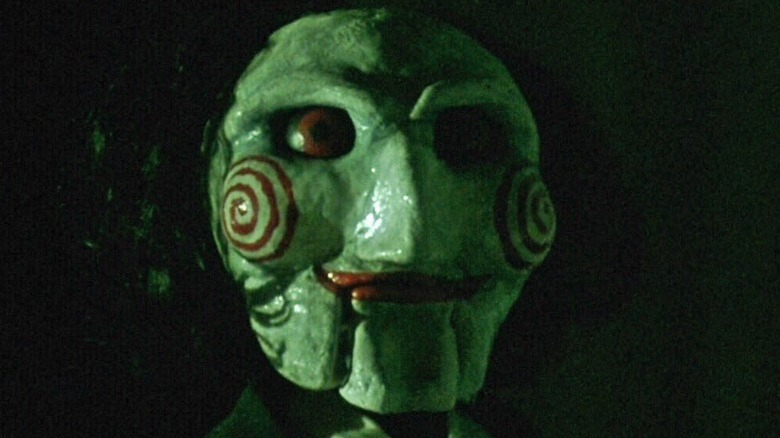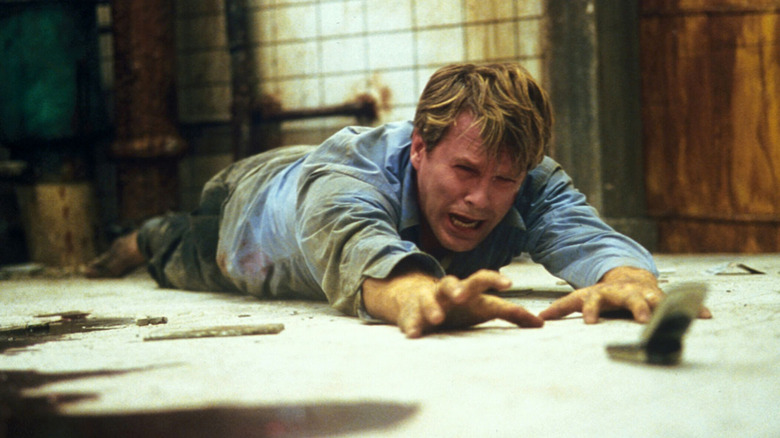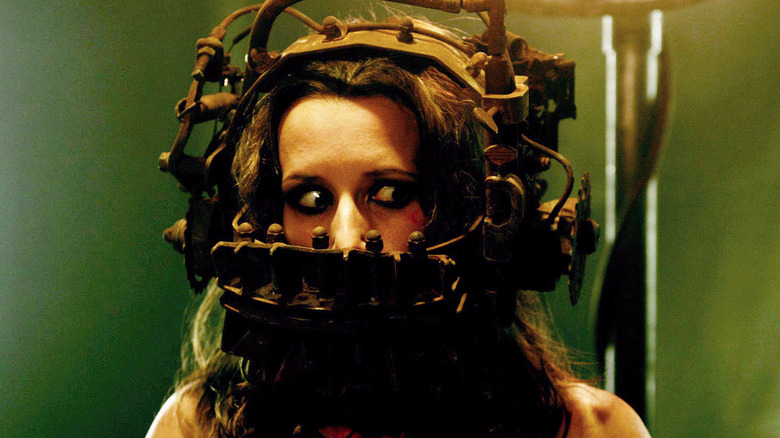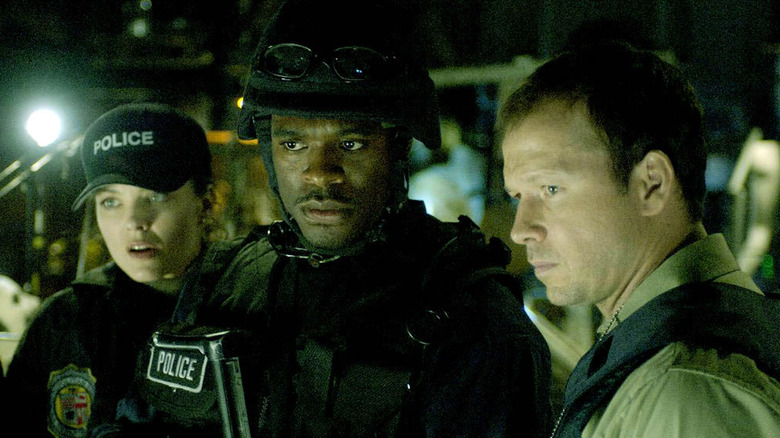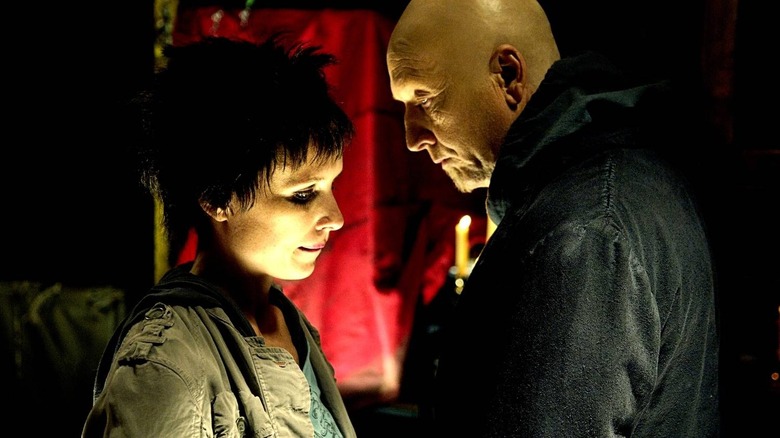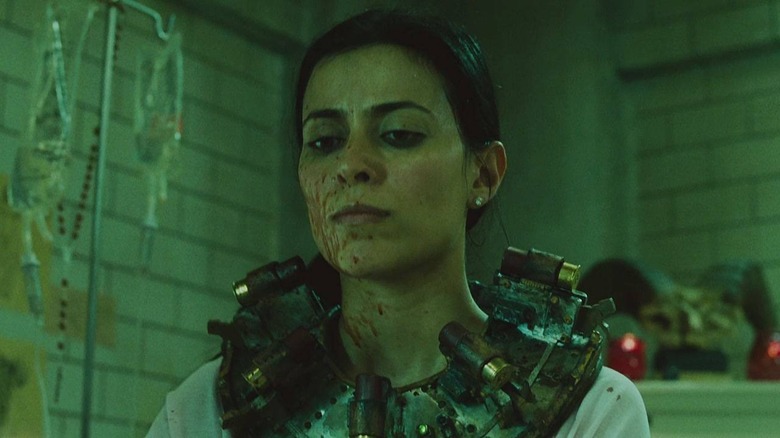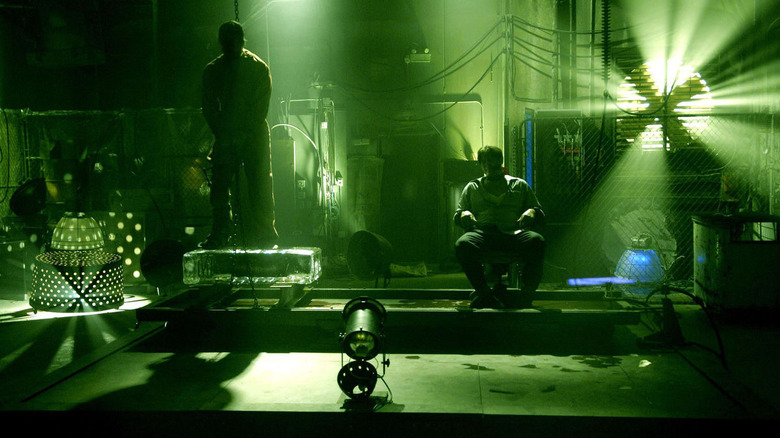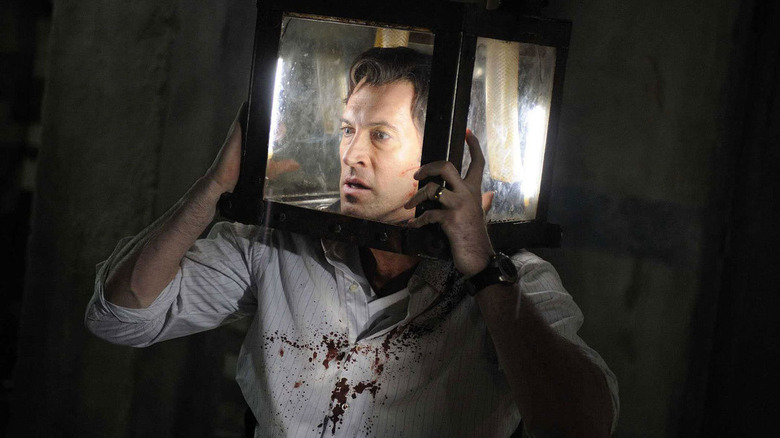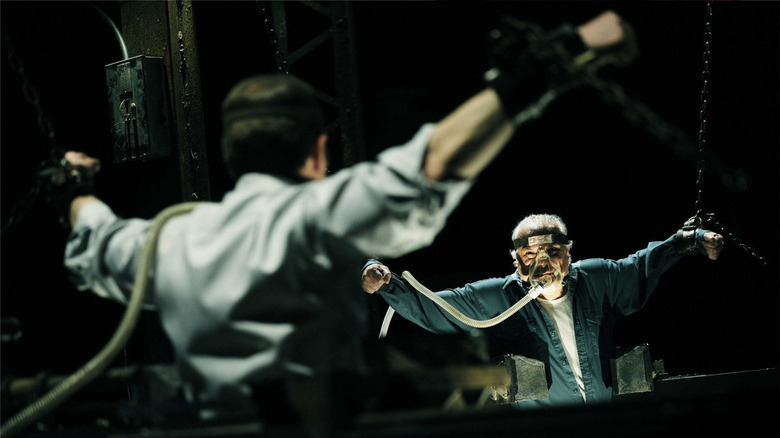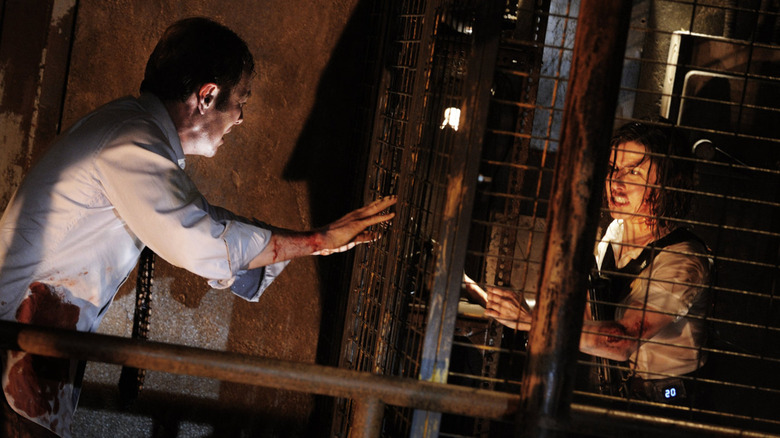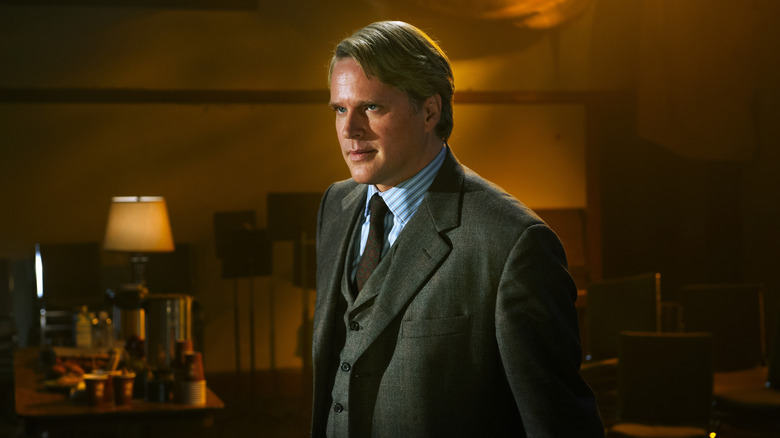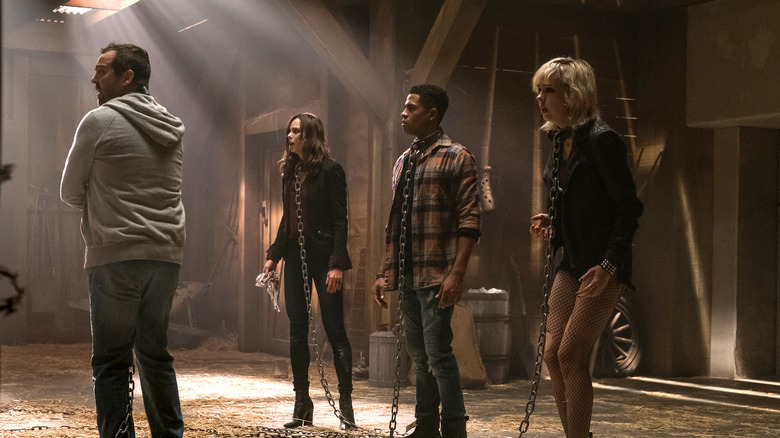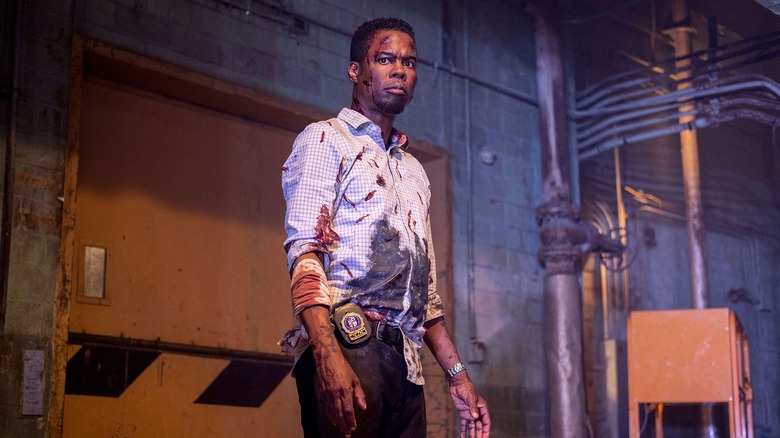The Box Office History Of Saw
In July 2010, the "Saw" franchise hit an incredible milestone. The Guinness World Records committee had dubbed the franchise the most successful horror film series of all time, with six films up to that point earning a then-lifetime gross of $733 million. Producer Mark Burg told Reuters that he was "in shock" that his series beat out other iconic horror properties like "Halloween" and "Friday the 13th." It helped that the "Saw" films were something fresh in the horror genre in the mid-2000s, with an emphasis on torture and a dark tone that fit the pop culture zeitgeist of the time. All of these accomplishments came from an original 2004 movie that itself started out as just a microbudget independent project from future major filmmakers James Wan and Leigh Whannell.
With subsequent entries like "Saw 3D" and "Jigsaw," the "Saw" franchise has seen its lifetime box office haul increase even more. Upcoming entry "Spiral: From the Book of Saw" promises to boost its earnings even further. Unpacking how the "Saw" movies got to this level of enduring financial success reveals a fascinating story about the box office highs and lows of individual installments in this series. Like the movies themselves, the box office history of "Saw" is full of twists, turns and unexpected developments. Through it all, one gets a clearer picture of how and why this franchise has stuck around in the pop culture consciousness.
Saw becomes a surprise hit
Originally, "Saw" wasn't even supposed to hit theaters. Lionsgate initially planned to just drop the grimy thriller on home video. However, the film's buzzy presence at a series of 2004 film festivals persuaded the studio to give "Saw" a theatrical wide release at the end of October 2004. Going this route turned out to be a wise idea. "Saw" ended up opening to $18.2 million, already wildly above its $1.2 million budget. Thanks to positive word-of-mouth, "Saw" managed to hold better on subsequent weekends than many of its sequels.
In the end, the initial "Saw" made $55 million domestically, a little over three times its opening weekend, and secured a $103.8 million worldwide haul. What was once set to linger in Wal-Mart DVD aisles across the country had ended up becoming a box office phenomenon. The movie's then-groundbreaking approach to horror — rooting things in unnerving realism and torture scenarios — made it stand out in the marketplace. Audiences were more than willing to play a game with "Saw" on the big screen and helped to inspire a long-running horror franchise in the process.
Saw was one of the most profitable movies ever
History is full of low-budget horror movies that became some of the most profitable films of all time. "The Texas Chainsaw Massacre," "Night of the Living Dead," the original "Halloween," and even "Get Out" were all made on shoestring budgets but all became such massive box office successes that they generated enormous levels of profit. So it was with the original "Saw," which cost just $1.2 million to make and grossed $103.8 million worldwide. You don't need to be an accountant to recognize that such a box office haul renders the original "Saw" an incredibly profitable enterprise.
The lucrative nature of the original "Saw" was made explicit in the Sara Caldwell book Splatter Flicks: How to Make Low-Budget Horror Films, in which the author notes that the first "Saw" movie is among the 20 most profitable movies ever made. This achievement, along with the low budgets of subsequent entries in the franchise, makes it apparent why Lionsgate opted to turn "Saw" into an annual fixture at movie theaters. Like so many horror movies before it, the original "Saw" realized you didn't need a big budget to lure in big crowds of moviegoers. It was a practice that would continue for many of its sequels, which would also adhere to a low-budget model when it came to graphic scares.
Saw II tops the domestic box office
In a year, "Saw" went from being an unknown quantity to a franchise to be reckoned with. But as "Saw II" prepared to hit theaters, it was easy to ponder if maybe the original "Saw" was merely a fluke and that moviegoers wouldn't be interested in return trips to this universe. However, any doubts about "Saw" being able to sustain a thriving franchise were obliterated once "Saw II" opened to a fantastic $31.7 million. Not only was this significantly higher than the opening weekend of its predecessor, but this figure put "Saw II" atop the domestic box office, a sharp contrast to when the original "Saw" premiered in third place at the domestic box office.
"Saw II" distributor Lionsgate attributed this powerful debut to the residual goodwill of the original movie. "First of all, the original 'Saw' was a satisfying film for horror fans," former Lionsgate president of domestic distribution Steve Rothenberg told Box Office News at the time. "The film left a good taste in their mouth. Then, in addition, the film had a great afterlife on DVD, selling over four million units." With a beloved original movie plus a release date timed directly to Halloween, it was no surprise that "Saw II" managed to score such an impressive box office haul.
Saw III sets a Halloween record
For its third installment, the producers of "Saw" took an "if it ain't broke, don't fix it" approach to the movie's release date. A Halloween weekend premiere had worked so well for the first two movies, why not keep to that? "Saw III" debuted over Halloween weekend in 2006 and managed to score another strong opening weekend for the franchise. But this achievement went deeper than just notching a solid opening: "Saw III" managed to set a weekend record that would stand for years afterwards.
With a $33.6 million opening weekend, "Saw III" leaped past the openings of the first two movies to score the biggest debut ever for the franchise. Even better, it managed to procure the biggest opening ever for a Halloween weekend release. It would hold onto that record for five years until the $34 million opening of "Puss in Boots." Halloween has long been a haven for horror movies, but no singular franchise had managed to corner this timeframe in such a consistently successful fashion before. With "Saw III," the "Saw" series hit a record-shattering opening weekend that cemented its dominance over this holiday.
Saw III hit a series high worldwide
With its third entry, the "Saw" movies were officially box office juggernauts. This status was cemented with "Saw III," which hit a domestic opening weekend high for the series with a $33.6 million debut. However, the real box office strength for "Saw III" came in its international presence. This was one horror series whose appeal was not limited to just one country. "Saw" had no problem traveling all over the world. This international presence managed to notably increase with the third entry in the series.
"Saw III" scored a sizeable $84.6 million internationally for a $164.8 million worldwide haul. That's still the biggest worldwide take for any entry in the "Saw" franchise. In fact, it's still the only entry in the series to have grossed over $150 million worldwide. Such a massive gross made the movie unbelievably profitable, given that "Saw III" cost just $10 million to make. Though the "Saw" franchise wasn't done producing profitable films, "Saw III" did represent a peak for the franchise in terms of its global box office appeal.
The steady success of Saw IV
With "Saw IV," the "Saw" movies found themselves in a steady place financially. No new records were shattered here, but that was perfectly acceptable given that the film proved reliably successful at the box office. This was apparent when "Saw IV" grossed $31.7 million on opening weekend, a step down from the debut of "Saw III," but it did mark the third "Saw" entry in a row to open to over $30 million domestically. This impressive feat paved the way for the film to eventually amass a $63.3 million domestic gross.
If there was a drawback to "Saw IV" and its domestic run, it's that it solidified how frontloaded the franchise had become. The opening weekend of "Saw II" comprised just 36% of its domestic run while the same frame for "Saw III" was responsible for just 41% of its domestic gross. By comparison, "Saw IV" got 50% of its entire domestic gross from its first three days of release. The "Saw" movies were still popular, but they were now clearly only appealing to hardcore fans of the franchise rather than the general public. This was further reflected in how "Saw IV" grossed 21% less than its predecessor domestically.
The worrisome signs of Saw V
With "Saw V," the series failed to debut in the number one spot at the domestic box office for the first time since the original "Saw." This was tempered by the fact that "Saw V" lost the number one spot to "High School Musical 3: Senior Year." None of the other "Saw" sequels, save for "Saw II," opened directly against a movie a big as this kid-skewing sequel. Of course, Jigsaw's grisly new movie couldn't compete with that.
It also helped that "Saw V" still scored a respectable opening in its own right as it debuted to $30 million, the fourth consecutive time a "Saw" movie had opened to over $30 million domestically. However, the frontloaded problems that grew apparent with "Saw IV" were now unmistakable on "Saw V" as this title made a whopping 53% of its domestic gross from its opening weekend. The days of the original "Saw" tripling its opening weekend thanks to strong word-of-mouth was now a distant memory. Though "Saw V" still grossed $56.7 million, that was a worrisome 36% decline from the $87 million domestic gross of "Saw II" from just three years prior. As it would turn out, "Saw V" was only the beginning of the financial bleeding for this horror series.
Saw VI craters the franchise at the box office
The enduringly successful nature of the "Saw" franchise couldn't last forever. Every long-running horror series eventually hits its financial nadir, and it was merely inevitable that "Saw" would do the same. Even considering that, it was still shocking just how abruptly the series ran out of gas. In October 2009, "Saw VI" opened in the usual late October release window for "Saw" movies, but it only opened to $14.1 million. That marked a significant 53% plummet from the opening weekend of "Saw V" while also registering as the lowest-grossing "Saw" opening weekend ever. Even the original "Saw" managed to perform better than this new movie riding the coattails of five prior "Saw" entries.
The bad news wasn't over yet. The film proved to be one of the most frontloaded titles in the entire series and largely vanished from theaters by mid-November 2009. Once its domestic run was finished, "Saw VI" hadn't even doubled its opening weekend, taking in a $27.6 million gross. That was below the opening weekend of all the other "Saw" sequels. The budget on "Saw VI" may have been just $11 million but it was clear this franchise had hit a massive speed bump at the box office.
Why did Saw VI hit a new low worldwide?
The biggest culprit behind "Saw VI" bringing such a drastic box office decrease to the franchise might have been fellow October 2009 horror movie "Paranormal Activity." This was the kind of low-budget word-of-mouth-driven horror film that the original "Saw" movie functioned as five years prior. Audiences were coming out in droves for the fresh new take on horror storytelling found in "Paranormal Activity." "Saw VI," whose marketing didn't offer up anything new to moviegoers beyond promising more torture scenes, just couldn't compete.
It didn't further help that the "Saw" movies had become parodies of themselves at this point. The hallmarks of this franchise had become so familiar to moviegoers that they were no longer as successful functioning as scary movies. It's a problem plenty of other long-running horror franchises, namely "Friday the 13th," have also run into. Jigsaw couldn't outrun this classic horror movie problem. Finally, there's also the fact that the "Saw" movies had been on a downward trend domestically since "Saw II." This wasn't so much a problem when "Saw III" only made 9% less than "Saw II" domestically, but "Saw V" only making $1 million more than the original "Saw" should've been a sign that the appeal of the series was getting narrower and narrower.
Even with all these signs, nobody could have predicted that "Saw VI" would sink the franchise to such staggering lows at the worldwide box office.
Saw 3D restores some box office luster
A year after "Saw VI" indicated that the franchise was on its last legs, here comes "Saw 3D" to try and inject some new life into this horror saga. Before its release, there were concerns over whether or not the "Saw" producers were in for a repeat of its predecessor's grisly box office. This was especially on people's brains given what an erratic year digital 3D was having at the domestic box office. For every "Toy Story 3" that thrived in the format, there was a "My Soul to Take" that took digital 3D to a new box office low.
Turns out, though, there were still some drops of life left in this saga. When it dropped on the last weekend of October 2010, "Saw 3D" opened to $22.5 million, a 60% increase over the opening weekend of "Saw VI." It also put the franchise firmly back into the top spot at the domestic box office, despite "Paranormal Activity 2" debuting to strong box office figures one week prior. This opening was also big enough to make "Saw 3D" the fifth "Saw" movie to open at number one domestically. Though its debut fell below most of the other "Saw" sequels, "Saw 3D" still experienced a decent opening.
The complicated box office run of Saw 3D
Unpacking whether or not "Saw 3D" was a hit is a complicated question. On the one hand, the film was a massive step up from "Saw VI" in its domestic box office run and surpassed that movie's entire domestic gross by its fourth day of release. However, despite having more expensive ticket prices and the promise of being "the final chapter" in its marketing, "Saw 3D" still fell behind most other "Saw" movies. In fact, at the time, its $45.7 million domestic gross was lower than every other "Saw" movie save for "Saw VI."
On the other hand, the film actually hit a new high for the franchise in international territories, where it grossed $90.7 million. That alone was more than four times the movie's $20 million budget. This gross served as a testament not only to how appealing "Saw" movies were for international moviegoers but also how the digital 3D format had such a major pull overseas. Though it couldn't get the "Saw" franchise back to its glory days domestically, "Saw 3D" did manage to score an international haul big enough to save some financial face.
Jigsaw tries to sharpen the appeal of the Saw movies
Seven years after "Saw 3D" seemed to close the book on the franchise, the series returned with "Jigsaw." That title and the lack of previously existing characters seemed to suggest that "Jigsaw" was trying to craft a quasi-reboot for the series. This and the prolonged absence of "Saw" from movie theaters were used in the marketing to juice up the box office of "Jigsaw."
Neither element really helped the project stand out financially, as "Jigsaw" opened to just $16.64 million, the second-lowest domestic bow in the franchise. For comparison's sake, the original "Saw" opened to a better figure in 2004 and that's without either "Saw" establishing itself as a famous brand or taking inflation into account. Part of the problem was that the marketing for "Jigsaw" failed to convey to audiences why the franchise was returning after such a lengthy absence. There was no promise of a big new story to tell nor the hint of long-lingering questions getting answered. It was just promoted as yet another "Saw" movie, which the modern horror scene just wasn't clamoring for. Moviegoers had managed to get by with other horror movies in the seven years since "Saw 3D," so the demand just wasn't there for what "Jigsaw" was offering.
Box office expectations of Spiral
Seeing that "Jigsaw" failed to drum up much interest from moviegoers by just announcing itself as a new "Saw" movie, Lionsgate was going to need something drastically different the next time the studio stepped up to the plate with the franchise. Enter "Spiral: From the Book of Saw," which is set in the "Saw" universe but is told as a crime thriller a la "Se7en" rather just a torture porn horror movie. For the first time, the "Saw" franchise is also employing well-known actors in the form of Chris Rock and Samuel L. Jackson.
Lionsgate has big hopes for the project, as evidenced by how it moved "Spiral" from the usual "Saw" release spot of late October to mid-May 2020, where the studio found enormous success with the third "John Wick" movie in 2019. However, "Spiral" was thrown for a loop greater than any plot twist in a "Saw" movie when its release was delayed a whole year by the COVID-19 pandemic. Now, "Spiral" is set to open as one of the first major titles bowing theatrically in the domestic market. The most recent projections for the film predict it'll open to $10-15 million. An opening in that range wouldn't be far off from the disastrous bow of "Saw VI," but it would mark one of the bigger openings for a domestic release in a marketplace impacted by COVID-19. Only time will tell what "Spiral" will add to the long box office history of "Saw."
